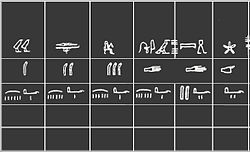This is an old revision of this page, as edited by Justlettersandnumbers (talk | contribs) at 12:39, 26 August 2011 (make a start, remove unref). The present address (URL) is a permanent link to this revision, which may differ significantly from the current revision.
Revision as of 12:39, 26 August 2011 by Justlettersandnumbers (talk | contribs) (make a start, remove unref)(diff) ← Previous revision | Latest revision (diff) | Newer revision → (diff) For the unit of information entropy, see Ban (information). For other uses, see digit.The digit or finger is an obsolete non-SI unit of measurement of length, originally based on the breadth of a human finger. It was a fundamental unit of length in the Ancient Egyptian, Mesopotamian, Hebrew, Ancient Greek, and Roman systems of measurement. In astronomy a digit is the one twelfth of the diameter of the sun or the moon.
History
Ancient Egypt

The digit, also called a finger or fingerbreadth, is an anthropic unit, originally based on the breadth of a human finger. It was the basic unit of subdivision of the cubit.
On surviving Ancient Egyptian cubit-rods, the royal cubit is divided into seven palms of four digits or fingers each. Five digits are equal to a hand, with thumb; and six to a closed fist. The royal cubit measured approximately 525 mm, so the length of the ancient Egyptian digit was about 19 mm.
| Name | Egyptian name | Equivalent Egyptian values | Metric equivalent | ||||
|---|---|---|---|---|---|---|---|
| Royal cubit |
|
7 palms or 28 digits | 525 mm | ||||
| Fist | 6 digits | 108 mm | |||||
| Hand | 5 digits | 94 mm | |||||
| Palm |
|
4 digits | 75 mm | ||||
| Digit |
|
1/4 palm | 19 mm |
British measurements
A digit (lat. digitus, "finger"), when used as a unit of length, is usually a sixteenth of a foot or 3/4" (1.905 cm for the international inch). The width of an adult human male finger tip is indeed about 2 centimetres. In English this unit has mostly fallen out of use, as do others based on the human arm: finger (7/6 digit), palm (4 digits), hand (16/3 digits), shaftment (8 digits), span (12 digits), cubit (24 digits) and ell (60 digits).
It is in general equal to the foot-nail, although the term nail can also be used as 1/16 of yard and other units.
See also
References
- Hosch, William L. (ed.) (2010). The Britannica Guide to Numbers and Measurement (1st ed.). New York, NY: Britannica Educational Publications. p. 203. ISBN 978-1615301089.
{{cite book}}:|first=has generic name (help) - Selin, Helaine (ed.) (1997). Encyclopaedia of the History of Science, Technology and Medicine in non-Western Cultures. Dordrecht: Kluwer. ISBN 9780792340669.
{{cite book}}:|first=has generic name (help) - ^ Clagett, Marshall (1999). Ancient Egyptian Science, A Source Book. Volume 3: Ancient Egyptian Mathematics. Philadelphia: American Philosophical Society. ISBN 9780871692320.
- Lepsius, Richard (1865). Die altaegyptische Elle und ihre Eintheilung (in German). Berlin: Dümmler.
This standards- or measurement-related article is a stub. You can help Misplaced Pages by expanding it. |